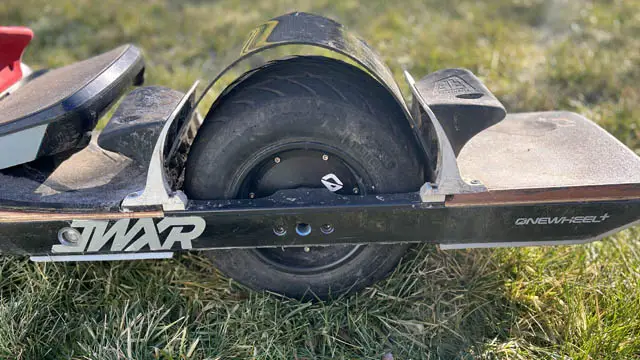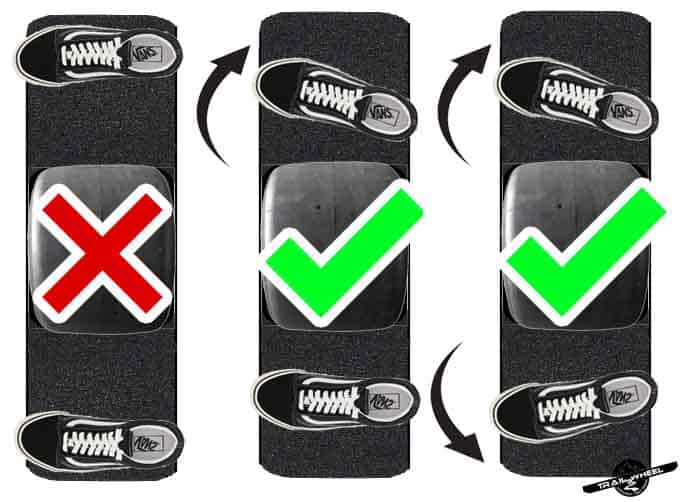
Riding a Onewheel on grass can be a fun way to get around (especially if its out on a golf course) but there are some things you should know before you take your board out for a spin. Yes, the Onewheel can totally handle grass however depending on how soft the dirt is, it may or may not be that enjoyable to ride. In this article, we’ll discuss six things that are essential to keep in mind when riding a Onewheel on grass. From tire pressure to speed control, these tips will help ensure that your next outdoor adventure is both fun and safe. Let’s get started!
Tire pressure on a Onewheel
Check out our tire PSI calculator for Onewheels. This can help dial you in to the right pressure. Because all of our body weight is on one wheel, the ride is drastically changed with how much air we cram into the Onewheel. The pneumatic tires on a Onewheel are great for off-roading however air pressure varies depending on what you are riding. For grass, you should aim for a slightly lower tire pressure than when riding on pavement or hard surfaces. This will provide better traction and stability as you move over uneven ground.
Remember however that when you lower the PSI, you do get a lower overall range. Some riders no not even notice the difference whereas some other (often riders that weigh 190+lbs) see notable range losses). Its something to consider and always keep on hand a simple battery air pump. I use a Ryobi air pump / compressor which works fantastic. I can go almost a full season without having to charge the battery.
Speed Control – Control your speed on grass
One of the most important things to keep in mind when riding a Onewheel on grass is speed control. Keep your speed low and steady, especially when going up inclines or around corners. Maintaining a slow and controlled speed will help ensure that your board stays balanced, allowing you to ride safely and confidently.
A tip to consider is you never want to go too slow. When you go slow, the motor has no built up momentum to carry you (the rider) over any obstacles or objects (such as a rock, root, branch, dip in the ground, etc). Try to always keep a goo amount of momentum (at least 5 mph) so that you just bump over most obstacles.
Foot Positioning – Foot placement matters
Your foot position can have a huge impact on stability while riding a Onewheel on grass. It is important to keep your feet firmly planted on the board in order to maintain balance and control. Stand with both feet slightly wider than hip-width apart as well. One way to avoid wobbles or imbalance is to point the leading toe or both toes outward. This improves your diagonal tension which provides the best stabilization on a Onewheel.

Surface Type – Hard, soft, wet and uneven terrain
One of the biggest challenges about riding through a field of grass is that it can be unpredictable especially if the grass is long. It’s important to pay attention to the type of surface you are riding on.
Always be scanning with your eyes the area within 15 feet in front of you. Its ok to glance away for a second or two but every 3-5 seconds your eyes should be focused on the path ahead of you.
Hard terrain can be more predictable and easier to ride. A hard fairway green or a smooth manicured lawn can be more fun as you can go a little faster and not feel like you’re going to fall off at any moment. With soft terrain (wet grass, softer soil, viscous mud), you really need to take caution and be alert. While Its always recommended to carve on your trail rides, carving on soft or wet terrain can result in a slip. It will take practice to get a feel of what speed is most comfortable for you in certain terrains.
The key to most terrains is to always keep it moving. Stopping or going very slow on softer terrain makes for a more challenging ride. The onewheel spends to much of its power attempting to balance that it often doesn’t have the torque to push you over obstacles. With a moderate speed, even a light jogging speed, if there are obstacles in the way, the momentum will help allow the Onewheel to pop over it.
If the grass is wet, a Onewheel can ride over it. I try to avoid puddles, but I am personally fine with riding on wet grass. You just need to be more careful. One morning ride, I was on a field that had frost on it. I went to bank a turn and I feel flat on my back. There wasn’t enough friction on the frosted grass to allow for me to carve or make a hard turn. The more experience you have riding wet or frosted grass, you will understand how far you can push it. To play it safe, keep to straight paths on wet surfaces!
On fields you also have to be concerned with mole paths, divots and small holes. Grass offers great camouflage to these items and they are obstacles you want to avoid. Riding a Onewheel over a mole path can set you up for a potential fall. The one wheel’s weight often will collapse the path and getting stuck under the ground and sending you off the board. Similarly, small holes will do the same. Keep a vigilant eye out and keep momentum.
- Always be visually scanning the terrain in front of you
- Avoid fields with grass longer than 2 inches
- Maintain momentum
- Take caution on wet or frosted grass
- Always be ready – holes and divots are harder to see
Braking – Just takes more time
Braking on grass doesn’t really change when it comes to grass riding however grass provides for less friction than concrete or asphalt. When you brake, you typically want to slow down over a longer distance. Short stops or making a quickstop can sometimes lead to wheelslip or a fall.
Its a tough fall when you are leaning back to slowdown on a onewheel and suddenly the Onewheel slips out from underneath you surprising you with a nice fall. No one wants that. Fortunately however this scenario is uncommon. The more you practice riding, the more you’ll understand on how much you can push the onewheel on any given terrain.
I enjoy skid stops on grass because it makes for a fun tail slide over the grass. If you are anticipating the slide, its fun. Otherwise its not. Just slowly work up to shorter and shorter stops. Know that obviously wet or frosted grass will not allow for fast stops. Slow down the stops over wet terrain.
Safety Gear – Is it necessary on grass?
There are times I will ride around in the yard for fun quickly and don’t put a helmet on. I can’t say that wearing gear is not recommended because it always is however on grass, its not as concerning as riding on asphalt. That being said however, I’ve taken more falls riding on grass than street riding believe it or not. The reason is grassy fields can be very unpredictable. There often are divots, holes, mole paths or even a rabbit hole. No one want to be stuck in a literal rabbit hole! So maybe the not all onewheel safety gear is needed, but definitely wear a helmet.
F.A.Q.’s
Golf courses have the best ridable grass around. There are private property or municipal courses. If you are golfing and you are using a Onewheel in lieu of a golf cart, typically municipal courses allow for it. You need to check with private establishments prior to going. Riding after business hours or while not golfing is trespassing therefore not allowed.
A densely packed and mowed field similar to a putting green on the golf course is the easiest grass to ride. As grass lengthens, it becomes more challenging to see obstacles that may be hidden (such as holes or divots). Take special caution with grass over 2-3 inches tall.
I find that grass riding is absolutely more taxing on the battery and my range definitely refects that. With my Pint X which typically gets around 12 miles to a charge, I’ll see about 8 miles riding on fields.
I would plan for a 20-40% loss of range depending on how thick the grass is and your body weight.
No. Grass does not damage a Onewheel. Riding through a large puddle may however grass does not damage the board.
Yes they can ride on snow along with a slew of different types of terrains. See our post on the types of terrain a Onewheel can ride over.
If you rode over it with a fender then you saved your leg from having dog crap flung all over your leg but the poop can still be lodged in the fender, under the bumpers and in the wheel (if you have a treaded tire). The best way I remove poop is either of two options. 1: Ride and continue to ride until its worn off or 2: Brush it off with a small brush. I always have a handheld brush in the trunk of my car to clean the debris off my board. Its an essential item you cant go without.

